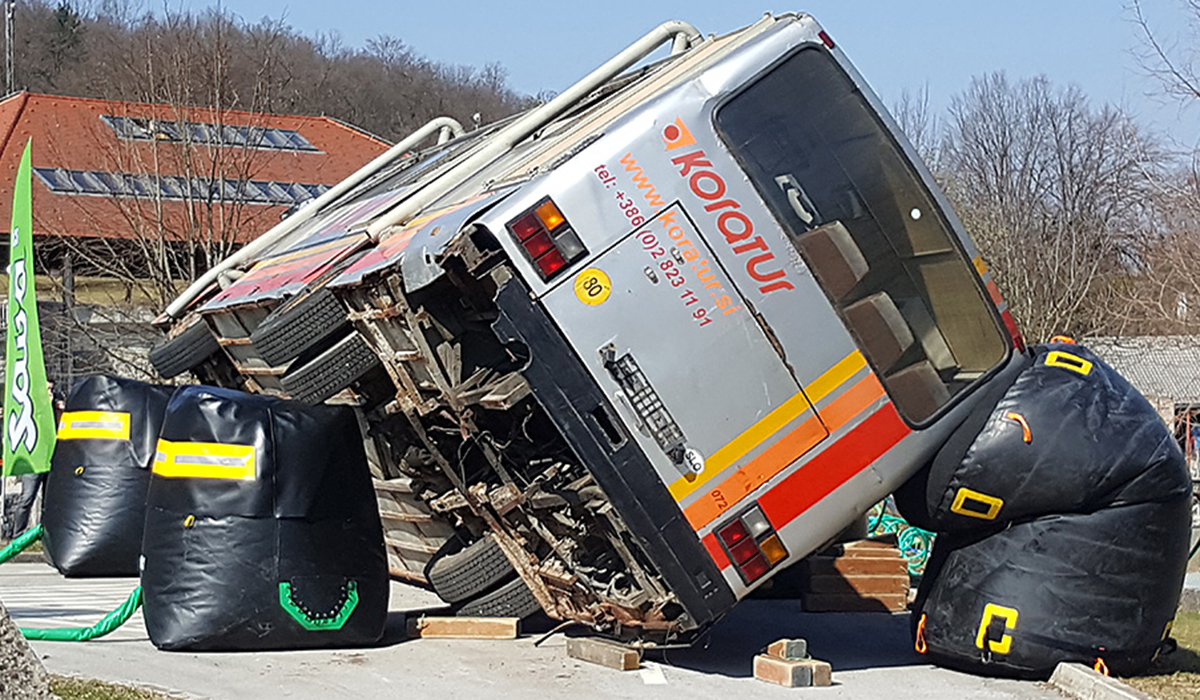
You’ve seen them deployed at recovery scenes by professional heavy-duty towing and recovery companies. Now, you’re thinking about adding a set to your operation. In today’s blog, we are going to answer some basic questions related to compressed air bag lifting systems.
Produced from thick, pliable rubber to withstand extreme weight loads, air bags rely on compressed air to lift heavy objects, upright overturned vehicles or shift loads to the proper location. The source of the air can vary, but each bag usually has its
own color-coded supply line for easy identification at the recovery scene.
Depending on the manufacturer, air bags range in size from 6” square to 57” in diameter and can reach up to 7’ tall. Square, high-pressure bags generally provide the initial clearance to insert taller bags, while cylindrical, low-pressure
bags finish the lift. Round landing or catch bags control the descent.
On heavy-duty rollovers--such as a tractor-trailer on its side in the ditch--a series of lift bags are positioned under the wall of the trailer. As the bags inflate, wide straps and slings from the wrecker on the roadside lift at the same time to assist
in the maneuver.

Catch or control bags are then placed underneath the casualty to soften the landing as the tractor-trailer reaches its critical tipping point. Straps from the wrecker also help control the landing, and as the weight of the trailer falls on the bags, air
is released as the casualty drops back on its feet.
By using air bags on both the lift and descent, heavy-duty tow operators are reducing the risk for further damage to the customer’s vehicle and the cargo inside. Depending on the weight of the load, semi trailer walls generally lack the structural
integrity for a recovery using straps alone.
Lifting in unison along the entire length of the trailer helps eliminate potential weak points. Deploying catch bags under the frame side of the trailer also helps reduce shock loading as the vehicle comes to a rest and thereby prevents a secondary rollover
due to a slingshot effect.
This controlled action protects rims, tires and suspension components from further damage. This maneuver also preserves--as best as possible--the cargo located inside the trailer and can usually prevent a costly and time-consuming off-load of the pallets
or freight.
Towing companies can generally recover the expense of air bag lifting systems by charging a separate line item for the service on their invoice. Depending on the size and quantity of a kit, the investment can be as high as $50,000. Most companies dedicate
a separate response trailer for the set up.
In addition to the air bags, other accessories required for a successful heavy-duty recovery may include an air compressor for the lift side, a blower for the landing side, air hoses to supply each bag and a deadman controller to operate all of the lifting
bags at once.
Frequently Asked Questions
To determine if an air bag system is right for your fleet, we put together a series of questions to help you make your decision:
Q: Are there different types of lifting bags?
A: Yes. High-, medium- and low-pressure lift bags in square or cylindrical shapes.
Q: What is the name of the bags which control the descent of a vehicle being uprighted?
A: Terms and descriptions vary among manufacturers, but they are typically referred to as
landing, catch or control bags.
Q: How is air generated for the bags?
A: The air can be supplied by a compressed gas cylinder, an air tank, a stand-alone compressor, a truck-mounted compressor, gas-powered blower
or even a manual foot pump.
Q: Are lifting bags safe to use?
A: Yes, lifting bags can withstand four times the bursting pressure safety factor (EN 13731).Accessories are also fitted with safety valves which
do not allow excessive pressure to build up.
Q: How do I choose a suitable lifting bag?
A: The following data is required to choose a suitable high-pressure lifting bag:
- Shape of the load
- Weight of the load
- Required lifting height
Q: Do lifting bags perform well on soft ground?
A: Lifting bags are made from flexible, durable rubber, and the wide footprint provides stability on any surface. They can function
in many different environments and weather conditions.
Q: What size lifting bag is the most popular size?
A: The 22''x22'' size is very popular. The working pressure of 116 PSI max translates to a 23.2 ton lifting capacity.
Q: How is the air pressure measured?
A: PSI (imperical) or Bar (metric). For example, an 8 Bar rated bag has a maximum pressure of 116 PSI.
Q: What is the typical lifespan of a lifting bag?
A: When properly maintained, you can use lifting bags up to 15 years before replacing.
Q: What is the biggest advantage of flat lifting bag compared to conventional one?
A: Flat lifting bags have greater surface contact and improved stability. You may be able
to stack more than one together, giving you the desired lifting height.